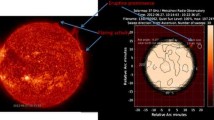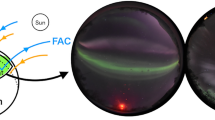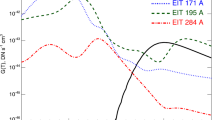Abstract
Strong thermal emission velocity enhancement (STEVE) is a recently identified, narrow, latitudinally extended, a subauroral glow ribbon of purple light. This glow is associated with the subauroral ion drift (SAID). This paper presents data from observations of the STEVE phenomenon that were conducted for the first time in Russia near the zenith of the Maimaga subauroral station (with geomagnetic coordinates 58°, 202°). The glow was registered with a digital all-sky imager equipped with six interference optical filters with effective bandwidth of 2 nm. The STEVE luminosity arose ~40 min after the onset of the substorm expansion phase that was more polar than the preexisting SAR arc. During the combined equatorial motion, the STEVE region reached the red arc. The STEVE luminosity began with the appearance of inhomogeneities moving westward. The STEVE thermal emission with a local enhancement of the 630.0 nm emission [OI] was caused by SAID. In our case, the SAID signature was the velocity of the westerly motion of inhomogeneities, ~840 m/s. Approaching the station zenith, the inhomogeneities merged into a continuous strip and then into a narrow glowing ribbon STEVE existed ~1 h, and shifted equatorward by ~190 km. In the continuous emission spectrum, the red emission line [OI] dominated. The STEVE luminosity height was calculated.







Similar content being viewed by others
REFERENCES
Archer, W.E., Gallardo-Lacourt, B., Perry, G.W., St.‑Maurice, J.P., Buchert, S.C., and Donovan, E., Steve: The optical signature of intense subauroral ion drifts, Geophys. Res. Lett., 2019a, vol. 46, no. 12, pp. 6279–6286. https://doi.org/10.1029/2019GL082687
Archer, W.E., St.-Maurice, J.P., Gallardo-Lacourt, B., Perry, G.W., Cully, C.M., Donovan, E., Gillies, D.M., Downie, R., Smith, J., and Eurich, D., The vertical distribution of the optical emissions of a Steve and Picket fence event, Geophys. Res. Lett., 2019b, vol. 46, no. 19, pp. 10719–10725. https://doi.org/10.1029/2019GL084473
Barbier, D., L’arc auroral stable, Ann. Geophys., 1960, vol. 16, no. 4, pp. 544–549.
Cole, K.D., Stable auroral red arcs, sinks for energy of Dst main phase, J. Geophys. Res., 1965, vol. 70, no. 7, pp. 1689–1706. https://doi.org/10.1029/2018GL078509
Gallardo-Lacourt, B., Liang, J., Nishimura, Y., and Donovan, E., On the origin of STEVE: Particle precipitation or ionospheric skyglow?, Geophys. Res. Lett., 2018a, vol. 45, no. 16, pp. 7968–7973. 2018. https://doi.org/10.1029/2018GL078509
Gallardo-Lacourt, B., Nishimura, Y., Donovan, E., Gillies, D.M., Perry, G.W., Archer, W.E., Nava, O.A., and Spanswick, E.L., A statistical analysis of STEVE, J. Geophys. Res.: Space Phys., 2018b, vol. 123, no. 11, pp. 9893–9905. https://doi.org/10.1029/2018JA025368
Galperin, Yu.L., Ponomarev, V.N., and Zosimova, A.G., Plasma convection in the polar ionosphere, Ann. Geophys., 1974, vol. 30, no. 1, pp. 1–7.
Gillies, D.M., Donovan, E., Hampton, D., Liang, J., Connors, M., Nishimura, Y., Gallardo-Lacourt, B., and Spanswick, E., First observations from the TREx spectrograph: The optical spectrum of STEVE and the picket fence phenomena, Geophys. Res. Lett., 2019, vol. 46, no. 13, pp. 7207–7213. https://doi.org/10.1029/2019GL083272
Harding, B.J., Mende, S.B., Triplett, C.C., and Wu, Y.-J.J., A mechanism for the STEVE continuum emission, Geophys. Res. Lett., 2020, vol. 47, no. 7, e2020GL087102. https://doi.org/10.1029/2020GL087102
Hoch, R.J., Smith, L.L., and Clark, K.C., λ5577 [OI] and λ4278 \({\text{N}}_{2}^{ + }\) emissions in a SAR arc, J. Geophys. Res., 1971, vol. 76, no. 31, pp. 7663–7668. https://doi.org/10.1029/JA076i031p0766310.1029/JA076i031p07663
Hunnekuhl, M. and MacDonald, E., Early ground-based work by auroral pioneer Carl Størmer on the high-altitude detached subauroral arcs now known as “STEVE”, Space Weather, 2020, vol. 18, no. 3, e2019SW002384. https://doi.org/10.1029/2019SW002384
Ievenko, I.B., Dynamics of diffuse aurora and SAR arcs during a substorm, Geomagn. Aeron., 1993, vol. 33, no. 5, pp. 42–57.
Ievenko, I.B., Pulsating particle precipitations in the SAR arc region due to a substorm, Geomagn. Aeron., 1995, vol. 35, no. 3, pp. 37–46.
Ievenko, I.B., Effects of magnetospheric activity on the plasmasphere as inferred from observations of diffuse aurorae and SAR arcs, Geomagn. Aeron. (Engl. Transl.), 1999, vol. 39, no. 6, pp. 697–703.
Liang, J., Donovan, E., Connors, M., Gillies, D., St.‑Maurice, J.P., Jackel, B., Gallardo-Lacourt, B., Spanswick, E., and Chu, X., Optical spectra and emission altitudes of double-layer STEVE: A case study, Geophys. Res. Lett., 2019, vol. 46, no. 23, pp. 13630–13639. https://doi.org/10.1029/2019GL085639
MacDonald, E.A., Donovan, E., Nishimura, Y., et al., New science in plain sight: Citizen scientists lead to the discovery of optical structure in the upper atmosphere, Sci. Adv., 2018, vol. 4, no. 3, eaaq0030. https://doi.org/10.1126/sciadv.aaq0030
Parnikov, S.G., Ievenko, I.B., Baishev, D.G., and Koltovskoy, I.I., Proton aurora observation as a result of ion cyclotron instability, in Proc. SPIE 11560: 26th International Symposium on Atmospheric and Ocean Optics, Atmospheric Physics, Moscow: 2020, 1156086. https://doi.org/10.1117/12.2575266.
Schaeffer, R.C. and Jacka, F., Stable auroral red arc observed from Adelaide during 1967–69, J. Atmos. Sol.-Terr. Phys., 1971, vol. 33, no. 2, pp. 237–250. https://doi.org/10.1016/0021-9169(71)90200-5
Spiro, R.W., Heelis, R.A., and Hanson, W.B., Rapid subauroral ion drifts observed by atmospheric Explorer C, Geophys. Res. Lett., 1979, vol. 6, no. 8, pp. 657–660. https://doi.org/10.1029/GL006i008p00657
Stepanov, A.E., Khalipov, V.L., Golikov, I.A., and Bondar’, E.D., Polyarizatsionnyi dzhet: uzkie i bystrye dreify subavroral’noi ionosfernoi plazmy (Polarization Jet: Narrow and Fast Drifts of Subauroral Ionospheric Plasma), Yakutsk: SVFU, 2017.
Funding
This work was carried out within the framework of state assignment АААА-А21-121011990007-1 and partial support from the Russian Foundation for Basic Research, project no. 21-55-50 013.
Author information
Authors and Affiliations
Corresponding authors
Ethics declarations
The authors declare that they have no conflicts of interest.
Additional information
Translated by V. Arutyunyan
Rights and permissions
About this article
Cite this article
Parnikov, S.G., Ievenko, I.B. & Koltovskoi, I.I. Subauroral Luminosity STEVE over Yakutia during a Substorm: Analysis of the Event of March 1, 2017. Geomagn. Aeron. 62, 434–443 (2022). https://doi.org/10.1134/S0016793222030136
Received:
Revised:
Accepted:
Published:
Issue Date:
DOI: https://doi.org/10.1134/S0016793222030136




